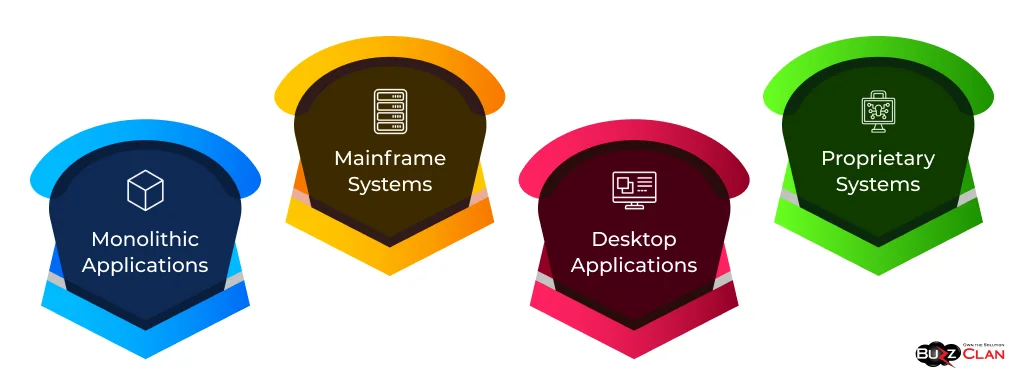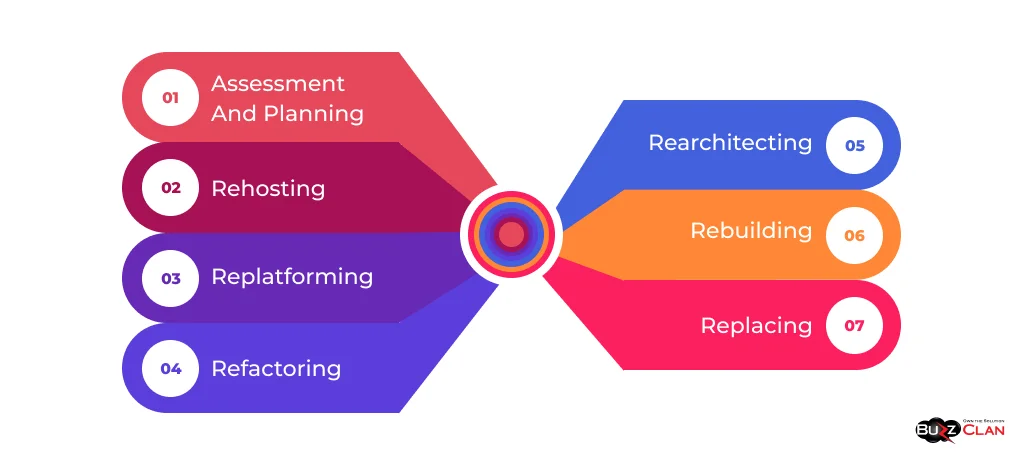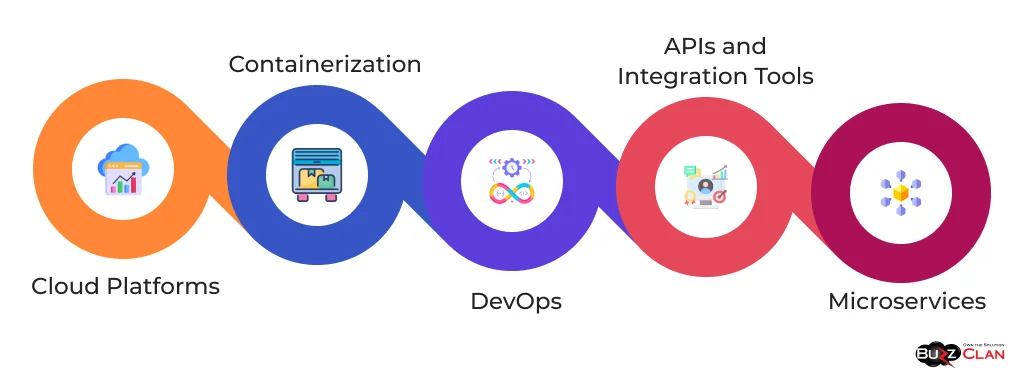The Ultimate Guide to Modernizing Legacy Applications
Deepa Desai
Jun 10, 2024
Introduction
In today’s rapidly evolving digital landscape, businesses face the daunting challenge of maintaining and modernizing their legacy applications. These outdated systems often hinder growth, limit scalability, and pose significant security risks. As technology advances at an unprecedented pace, organizations must adapt and transform their legacy applications to remain competitive and meet the ever-changing demands of their customers.
This comprehensive blog post provides a detailed guide on modernizing legacy applications. We will delve into the definition of legacy app modernization, explore the challenges associated with legacy systems, and highlight the benefits of modernization. Furthermore, we will discuss various strategies, tools, and technologies that can be leveraged to modernize legacy applications successfully. Through real-world case studies and examples, we will demonstrate how organizations have successfully transformed their outdated systems and reaped the rewards of modernization. By the end of this post, you will have a solid understanding of legacy app modernization and be well-equipped to embark on your modernization journey.
What is Legacy App Modernization?
Legacy app modernization refers to updating and transforming outdated software applications to align with current business needs and modern technology standards. It involves revamping existing applications’ architecture, functionality, and performance to improve efficiency, scalability, and user experience. Legacy app modernization is crucial for businesses to stay competitive, reduce technical debt, and leverage the benefits of modern technologies.
Legacy systems can take various forms, depending on the organization and the era in which they were developed. Some common types of legacy systems include:

- Monolithic Applications: Large, tightly coupled applications that are difficult to scale and maintain.
- Mainframe Systems: Outdated, costly, centralized computing systems that lack flexibility.
- Desktop Applications: These are traditional software applications installed locally on individual computers, often lacking web-based functionality.
- Proprietary Systems: Custom-built applications that rely on proprietary technologies make integrating modern tools and platforms challenging.
Challenges of Legacy Systems
Legacy systems pose several significant challenges for businesses, hindering growth and efficiency. Some of the key challenges include:
Operational Challenges:
Legacy systems often require extensive maintenance and support, leading to high operational costs. These systems may rely on outdated hardware, software, and programming languages, making it difficult to find skilled personnel to maintain them. Additionally, legacy systems often have complex, tightly coupled architectures, making modifying or updating them challenging without introducing errors or compatibility issues.
Security Risks:
Outdated systems are more vulnerable to security threats, as they may lack modern security features and patches. Legacy applications may have unaddressed security vulnerabilities that cybercriminals can exploit, leading to data breaches and reputational damage. Moreover, compliance with industry regulations and data protection standards becomes increasingly difficult with legacy systems.
Scalability Issues:
Legacy systems often struggle to meet modern businesses’ scalability demands. As organizations grow and their user base expands, legacy applications may fail to handle increased traffic and data volumes. This can result in poor performance, slow response times, and system crashes, negatively impacting user experience and productivity.
Benefits of Modernizing Legacy Applications
Modernizing legacy applications brings many benefits to organizations, enabling them to stay competitive and adapt to the ever-changing business landscape. Some of the key benefits include:
Improved Performance:
Modernizing legacy applications can significantly enhance performance, resulting in faster response times, increased throughput, and improved user experience. By leveraging modern technologies and optimizing application architecture, organizations can eliminate performance bottlenecks and ensure smooth operation even under high loads.
Enhanced Security:
Modernization allows organizations to incorporate the latest security features and best practices into their applications. By upgrading to modern platforms and frameworks, businesses can address security vulnerabilities, implement robust authentication and authorization mechanisms, and ensure compliance with industry standards and regulations.
Scalability and Flexibility:
Modernized applications are designed to be scalable and flexible, allowing organizations to accommodate growth and changing business requirements easily. By adopting modern architectures such as microservices and containerization, applications can be horizontally scaled to handle increased traffic and data volumes. This enables businesses to respond to market demands and seize new opportunities rapidly.
Cost Efficiency:
While modernization may require an initial investment, it can lead to significant cost savings in the long run. Organizations can allocate resources more effectively by reducing maintenance and operational costs associated with legacy systems. Modernized applications often require less manual intervention, enabling IT teams to focus on strategic initiatives rather than firefighting issues.
Strategies for Legacy App Modernization
Organizations can choose from various strategies based on their needs, goals, and constraints when embarking on a legacy app modernization journey. Some common modernization strategies include:

Assessment and Planning:
Assessing the existing legacy system thoroughly is crucial before undertaking any modernization effort. This involves analyzing the application’s architecture, functionality, dependencies, and integration points. Based on the assessment findings, organizations can develop a comprehensive modernization plan that aligns with their business objectives and technical requirements.
Rehosting:
Rehosting, or “lift and shift,” involves moving the legacy application to a new infrastructure without significantly changing the codebase. This strategy is suitable when the application’s functionality is still relevant but the underlying infrastructure is outdated. Organizations can benefit from improved scalability, reliability, and cost-efficiency by rehosting the application on a modern platform like the cloud.
Replatforming:
Replatforming involves migrating the legacy application to a modern platform while making minimal changes to the codebase. This strategy allows organizations to leverage the benefits of a new platform without extensively modifying the application’s functionality. Replatforming can include updating the database, modernizing the user interface, or integrating new services.
Refactoring:
Refactoring focuses on restructuring and optimizing the existing codebase without altering its external behavior. This strategy involves identifying and eliminating technical debt, improving code quality, and enhancing application performance. Refactoring can be done incrementally, allowing organizations to modernize their legacy applications gradually while minimizing disruption to business operations.
Rearchitecting:
Rearchitecting involves redesigning the application’s architecture to align with modern practices and technologies. This strategy is suitable when the legacy application’s architecture is no longer viable or scalable. Rearchitecting often involves breaking down monolithic applications into smaller, loosely coupled microservices, enabling better scalability, flexibility, and maintainability.
Rebuilding:
Rebuilding entails rewriting the legacy application from scratch using modern technologies and frameworks. This strategy is appropriate when the existing application is beyond repair or no longer meets the organization’s requirements. Rebuilding allows organizations to start with a clean slate and incorporate the latest best practices and design patterns.
Replacing:
Replacing the legacy application with a commercially available off-the-shelf solution may be more cost-effective and efficient. This strategy is suitable when an existing product can easily replicate the legacy application’s functionality or when the cost of modernization outweighs the benefits. Replacing legacy applications allows organizations to adopt modern capabilities quickly without extensive development efforts.
Tools and Technologies for Modernization
Organizations can leverage various tools and technologies to modernize legacy applications. Some of the key tools and technologies include:

Cloud Platforms:
Cloud platforms such as Amazon Web Services (AWS), Microsoft Azure, and Google Cloud Platform (GCP) are crucial in legacy app modernization. These platforms provide scalable, flexible, cost-effective infrastructure for hosting modernized applications. They offer various services, including compute, storage, database, and networking, enabling organizations to quickly deploy and manage their modernized applications.
Containerization:
Containerization technologies like Docker and Kubernetes have revolutionized how applications are packaged, deployed, and managed. Containers provide a lightweight and portable runtime environment, allowing applications to be easily moved across different platforms and environments. Containerization enables better resource utilization, faster deployment, and improved scalability, making it an essential tool for modernizing legacy applications.
DevOps:
DevOps practices and tools are vital for successful legacy app modernization. DevOps promotes collaboration between development and operations teams, enabling faster and more reliable application delivery. Tools like version control systems (e.g., Git), continuous integration and continuous deployment (CI/CD) pipelines (e.g., Jenkins, GitLab), and configuration management tools (e.g., Ansible, Puppet) streamline the modernization process and ensure consistent and automated application deployment.
Microservices:
Microservices architecture has gained significant popularity in recent years as a way to modernize monolithic applications. Microservices involve breaking down a large application into smaller, loosely coupled services that can be developed, deployed, and scaled independently. This approach improves modularity, scalability, and agility, allowing organizations to adapt rapidly to changing business needs.
APIs and Integration Tools:
APIs (Application Programming Interfaces) and integration tools connect modernized applications with existing systems and services. APIs enable secure and standardized communication between different applications, allowing seamless integration and data exchange. Integration platforms like MuleSoft, Apigee, and Dell Boomi help organizations to effectively manage and orchestrate APIs, ensuring smooth interoperability between modernized and legacy systems.
Case Studies and Examples
To illustrate the success of legacy app modernization, let’s explore two real-world case studies:
Case Study 1:
A large financial institution had a legacy mainframe system critical to its core banking operations. The system was expensive to maintain, lacked scalability, and posed significant security risks. The organization decided to modernize the system by adopting a hybrid approach. They retained the mainframe for certain core functions while migrating other components to a cloud-based microservices architecture. This approach allowed them to gradually modernize the system, reduce costs, and improve agility. The modernized system resulted in faster transaction processing, enhanced security, and the ability to launch new financial products rapidly.
Case Study 2:
A healthcare provider had a legacy electronic health record (EHR) system that was difficult to maintain and integrate with modern healthcare tools. The organization decided to modernize the EHR system by leveraging a low-code platform. They used the platform to rapidly develop and deploy new modules, automate workflows, and integrate with third-party systems. The modernized EHR system provided a more user-friendly interface, improved data accuracy, and enabled better collaboration among healthcare professionals. Due to the modernization effort, the organization achieved significant cost savings and improved patient outcomes.
Lessons Learned:
These case studies highlight several key lessons for successful legacy app modernization:
- Adopting a gradual and incremental approach can help mitigate risks and ensure a smooth transition.
- Leveraging modern technologies and architectures like cloud computing and microservices can significantly improve scalability, agility, and cost-efficiency.
- Engaging stakeholders throughout the modernization process is crucial for ensuring alignment with business objectives and user needs.
- Choosing the right tools and platforms based on the organization’s requirements can accelerate modernization and deliver tangible benefits.
Future Trends in Legacy App Modernization
As technology continues to evolve, several emerging trends are shaping the future of legacy app modernization:
AI and Machine Learning:
Artificial Intelligence (AI) and Machine Learning (ML) are increasingly being applied to automate and optimize modernization. AI and ML algorithms can analyze legacy codebases, identify patterns, and suggest optimizations. They can also assist in identifying dependencies, predicting performance issues, and recommending suitable modernization strategies. AI and ML can significantly reduce the manual effort required in the modernization process and improve the overall quality of the modernized application.
Serverless Architectures:
Serverless architectures are gaining traction as a way to modernize legacy applications. Serverless computing allows developers to focus on writing code without worrying about the underlying infrastructure. It enables automatic scaling, reduces operational overhead, and provides cost savings. Serverless architectures are particularly well-suited for event-driven and stateless applications, making them an attractive option for modernizing certain legacy components.
Low-Code/No-Code Platforms:
Low-code and no-code platforms transform the modernization landscape by enabling rapid application development and deployment. These platforms provide visual tools and pre-built components, allowing non-technical users to create and modify applications. Low-code/no-code platforms can significantly accelerate modernization, reduce development costs, and enable faster innovation. They are handy for modernizing legacy applications with less complex business logic.
Edge Computing:
Edge computing is becoming increasingly important in the context of legacy app modernization. It brings processing power closer to the data source, reducing latency and enabling real-time decision-making. As organizations modernize their legacy applications, they can leverage edge computing to improve performance, reduce network bandwidth consumption, and encourage new use cases like the Internet of Things (IoT) and real-time analytics.
Best Practices for Successful Modernization
To ensure a successful legacy app modernization initiative, organizations should follow these best practices:
Comprehensive Assessment:
Before starting the modernization journey, a thorough assessment of the legacy system is crucial. This assessment should involve analyzing the application’s architecture, dependencies, performance, security, and user requirements. A comprehensive assessment helps identify the most suitable modernization strategy and ensures all stakeholders clearly understand the current state and desired outcomes.
Stakeholder Engagement:
Engaging stakeholders throughout the modernization process is essential for success. This includes involving business users, IT teams, and executive sponsors in the planning, execution, and validation phases. Regular communication and collaboration help ensure the modernization effort aligns with business objectives, user needs, and technical requirements. Stakeholder engagement also helps manage expectations, mitigate risks, and foster a culture of continuous improvement.
Incremental Approach:
Adopting an incremental approach to modernization can minimize risks and ensure a smooth transition. Instead of attempting to modernize the entire legacy system at once, organizations can break down the process into smaller, manageable phases. This allows for iterative development, testing, and feedback, reducing the impact of any issues that may arise. An incremental approach enables organizations to realize benefits faster and adapt to changing requirements more effectively.
Continuous Testing:
Continuous testing is critical for ensuring the quality and reliability of the modernized application. Organizations should implement automated testing frameworks that cover unit tests, integration tests, and end-to-end tests. Continuous testing helps identify and fix issues early in the development cycle, reducing the risk of defects and performance problems in production. It also enables faster feedback loops and promotes a quality culture throughout modernization.
Change Management:
Effective change management is essential for successful legacy app modernization. Modernization often involves significant changes to processes, roles, and responsibilities. Organizations should develop a comprehensive change management plan that includes communication, training, and support strategies. Engaging employees in the change process, providing adequate training, and addressing concerns can help ensure a smooth transition and minimize resistance to change.
Conclusion
We have explored various modernization strategies, such as rehosting, re-platforming, refactoring, rearchitecting, rebuilding, and replacing, each suitable for different scenarios and requirements. We have also discussed the role of cloud platforms, containerization, DevOps, microservices, and APIs in enabling successful modernization.
Through real-world case studies, we have seen how organizations have successfully modernized their legacy applications and achieved significant benefits. These examples highlight the importance of gradually leveraging modern technologies, engaging stakeholders, and choosing the right tools and platforms.
Looking ahead, we have explored future trends in legacy app modernization, including the application of AI and machine learning, the rise of serverless architectures, the impact of low-code/no-code platforms, and the importance of edge computing.
To ensure a successful modernization initiative, organizations should follow best practices such as conducting a comprehensive assessment, engaging stakeholders, adopting an incremental approach, implementing continuous testing, and managing change effectively.
By embarking on a legacy app modernization journey, organizations can unlock the full potential of their applications, improve user experience, and drive business growth. With the right strategies, tools, and best practices, modernizing legacy applications can be a transformative endeavor that sets businesses up for long-term success in the digital age.
FAQs

Get In Touch











